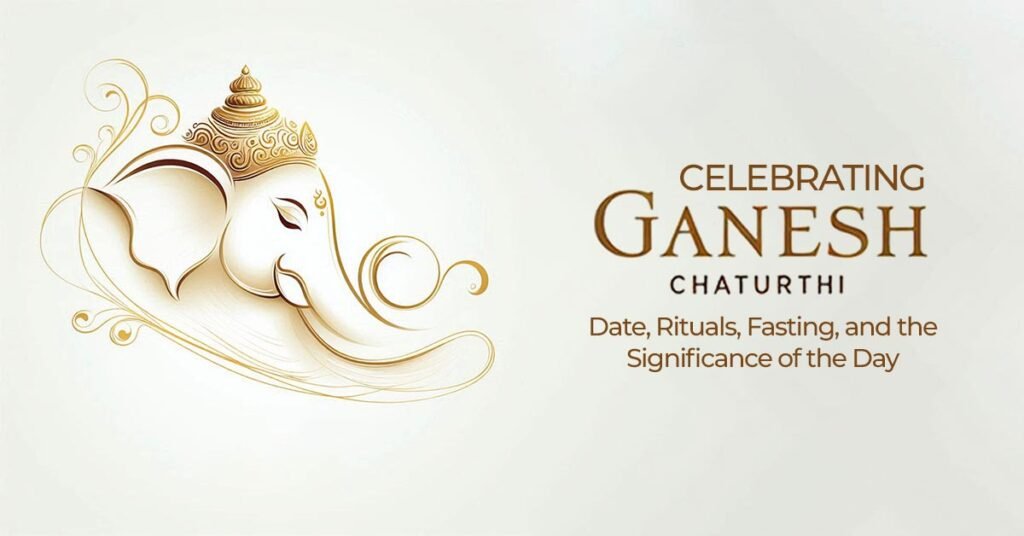No products in the cart.
Ghar mandir, Our Blog
Celebrating Ganesh Chaturthi: Date, Rituals, Fasting, and the Significance of the Day
Ganesh Chaturthi is a 10-day festival, dedicated to Lord Ganesha and observed with great enthusiasm across India, particularly in Maharashtra, Karnataka, Andhra Pradesh, and Tamil Nadu. The celebration blends age-old rituals, vibrant cultural expressions, and deep spiritual significance. Let us journey through the rituals, and spiritual essence of Ganesh Chaturthi, which inspire millions of devotees.
Ganesh Chaturthi Shubh Muhurat & Tithi:
The Shubh Muhurat to welcome गणेश जी is on Chaturthi Tithi starting at 3.01 PM on September 6th and concluding at 05:37 PM on September 7th. In addition, the Shubh Muhurat for Ganesh puja starts between 11.03 AM and 01.34 PM on September 7th.
The Rituals Of Ganesh Chaturthi
Ganesh Chaturthi is marked by elaborate rituals performed with great devotion and attention to detail. These rituals reflect the various aspects of Lord Ganesh’s divine nature and the spiritual journey of the devotees.
Pranapratishtha
Pranapratishtha is the sacred ritual that marks the beginning of Ganesh Chaturthi celebrations. During this ceremony, the idol of Lord Ganesha is consecrated, and life is symbolically infused into the statue through the chanting of powerful मंत्र and prayers. The priest, along with the devotees, invokes the presence of Lord Ganesha, inviting him to reside in the idol. This ritual is a deeply spiritual process, signifying the transition of the idol from a mere object to a divine embodiment of Lord Ganesha, ready to be worshiped during the festival.
Shodashopachara
Following the Pranapratishtha, the Shodashopachara ritual is performed. This ritual involves offering 16 different forms of offerings to Lord Ganesha. These offerings include flowers, fruits, sweets, incense, and other symbolic items, each representing a specific aspect of worship. The मोडक is commonly offered as it is the most favorite prasad of the Lord Ganesh. The Shodashopachara is a comprehensive form of worship that acknowledges the presence of the deity and expresses gratitude for his blessings. This ritual is repeated daily during the festival, ensuring that Lord Ganesha is honored and revered throughout the celebrations.
Uttarpuja
As the festival draws to the 10th day, the उत्तरपूजा ceremony is performed. This ritual signifies the end of the formal worship and visarjan of Lord Ganesha. The Uttarpuja is a joyous occasion as it marks the end of celebration by thanking the deity for his presence and blessings during the festival. The atmosphere is filled with devotion and
celebration as the devotees express their love and reverence for Lord Ganesha before the Visarjan ceremony.
Visarjan Puja
The end of Ganesh Chaturthi is the Visarjan Puja, during which the idol of Lord Ganesha is immersed in water. Devotees, often accompanied by music, dance, and chant “गणपति बप्पा मोरया,” carry the idol to a nearby river, lake, or sea for immersion. The Visarjan symbolizes the cycle of life and death, reminding devotees of the impermanence of all things. Also, the Visarjan is a time of hope, as devotees believe that Lord Ganesha will return the following year, bringing blessings and new opportunities for growth.
Fasting On Ganesh Chaturthi
उपवास on Ganesh Chaturthi is a spiritual practice observed by many devotees to honor Lord Ganesha and seek his blessings. The fast is believed to purify the mind and body, allowing devotees to focus on worship and spiritual reflection. Depending on their personal beliefs and physical capacity, devotees may observe different types of fasting.
Types Of Fasting
Nirjala Fast:
This is a strict form of fasting in which devotees refrain from consuming food or water throughout the day.
Phalahar Fast:
In this form of fasting, devotees abstain from grains, cereals, and lentils and instead consume fruits, milk, and water.
Sattvic Fast:
Devotees following a sattvic fast consume simple, sattvic foods that are pure, light, and easily digestible. This includes fruits, milk, nuts, and certain vegetables.
Steps To Break The Fast
Breaking the fast, also known as “parana,” is an important ritual that should be done with mindfulness and respect. The fast is typically broken after the Ganesh Chaturthi Puja, which is performed in the morning or the evening, depending on the family tradition or local customs.
Offer Prayers:
Before breaking the fast, devotees offer prayers to Lord Ganesha, expressing gratitude for his blessings and guidance throughout the day. The recitation of mantras, such as the Ganesh Gayatri Mantra or the गणेश श्लोक, usually accompanies the prayers.
Consume Prasad:
The fast is traditionally broken by consuming the prasad, which is food offered to Lord Ganesha during the Puja. This may include modak, a sweet dumpling made from rice flour, jaggery, and coconut, which is considered Lord Ganesha’s favorite. Other offerings like fruits, milk, or sweets may also be consumed.
Ganesh Chaturthi is a festival that transcends the boundaries of religion and culture, uniting people in a shared celebration of devotion, joy, and spiritual awakening. The festival’s rich history, intricate rituals, and profound spiritual significance make it a cherished occasion for millions of devotees worldwide. As Ganesh Chaturthi approaches, reach out to Ghar Mandir to book an online puja booking services in your name at the temple, ensuring your prayers and devotion are conveyed even if you’re unable to visit in person.

